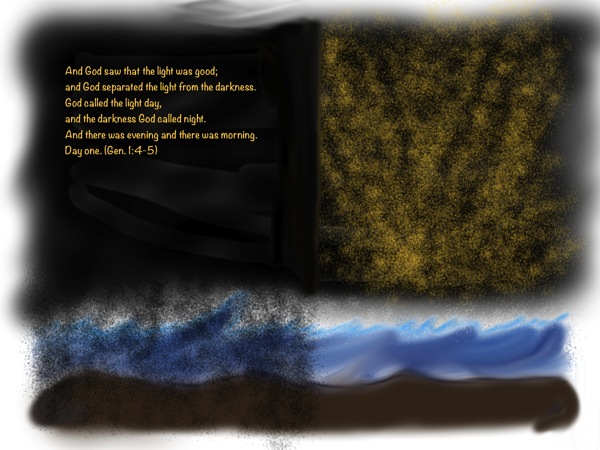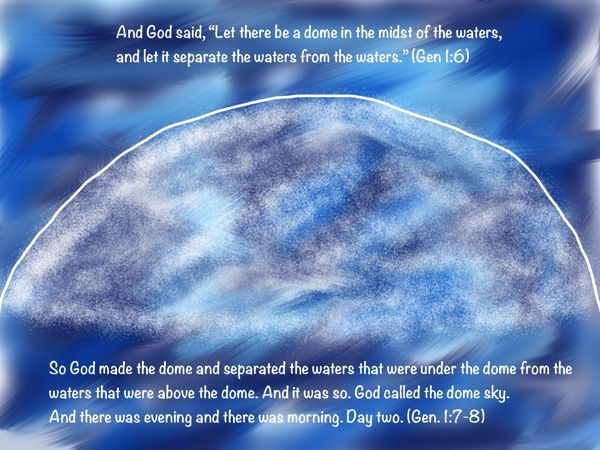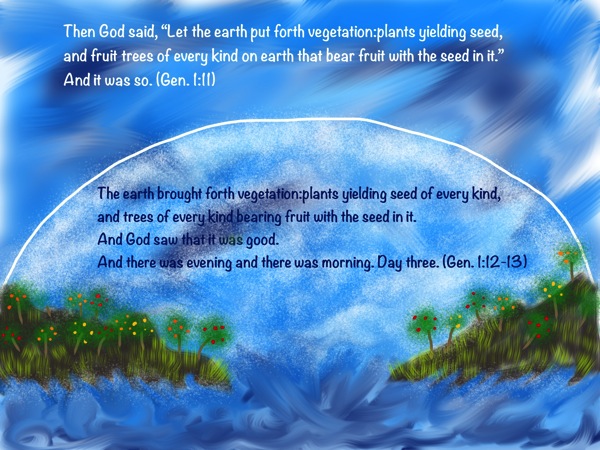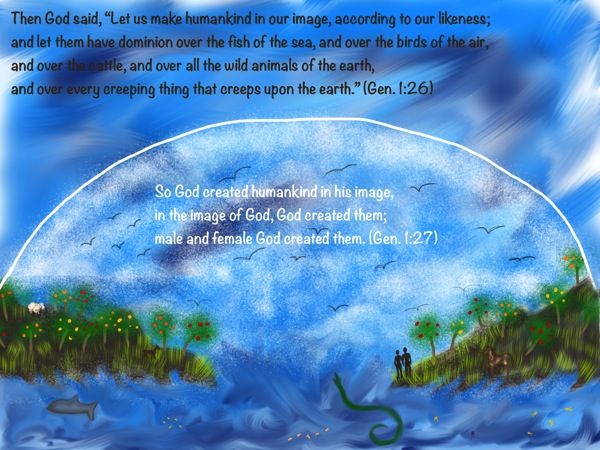Reading Genesis 1 “Literally”
Most people who claim they read Genesis 1 “literally” don’t. They believe that what they believe about Genesis 1 is literal. But they aren’t reading Genesis 1 literally.
If we read Genesis 1 literally, we come out with a very different picture than most literalists imagine. Indeed, we find ourselves firmly planted in the Hebrew worldview—an ancient worldview. And, if we know our history, we know that the Hebrews had no concept of a round earth that coursed around the sun. They believed the earth was flat, the sky was a dome, and the sun revolved around the earth.
So, let”s take a close, literal reading of Genesis 1. I’ve tried to illustrate the events as best I can.
Gen. 1:1
“In beginning God created the heavens and the earth.” This is a topic sentence that introduces the chapter. It can also be translated, “When God began creating the heavens and the earth . . .” introducing the next verse. By the way, the word “the” doesn’t appear in the Hebrew (it’s just “in beginning,” not “in the beginning.”

Gen. 1:2
“And the earth was desolate and barren, and darkness hovered over the surface of the deep, and the breath of God blew over the surface of the waters.”

Do you notice something here? I mean, really? There’s already something in existence before God starts saying “Let there be.” There is an earth that is desolate and barren (more on that in a minute). There is darkness. There is a deep that covers the earth (this becomes more evident later in Gen. 1:9). And God’s breath is blowing over the surface of the waters.
Usually translations render the Hebrew expression tohu vabohu as “formless and void.” This is unfortunate and misleading, because to Western ears “formless and void” sounds like vast emptiness, somewhat like our concept of space. But that’s not what the writer is saying. In fact, in the only other place the expression tohu vabohu is used (Jer. 4:23), it clearly refers to a desolate wasteland, not empty space (see also Jer. 4:26).
The desolate earth is covered by the deep which itself is covered by darkness. This is why God’s first creative act is to create light. And God’s breath is blowing over the surface of the deep. Now, this sentence can be translated a variety of ways: “And God’s spirit hovered over the surface of the deep” (by far the most popular Christian translation); “And a wind from God blew over the surface of the deep.” Or the way I translated it. I prefer the “God’s breath” translation because it fits in with the Genesis 2 account of God’s breath animating the first human (Gen. 2:7). God’s breath blowing over the deep brings life (see also Gen. 8:1).
Gen. 1:3
“And God said, ‘Let there be light!’ And there was light.”

Now the actual creative words begin. And the first thing God creates is light. But, . . . the Bible says that the sun isn’t created until day four (Gen. 1:14-19). So, clearly the writer of this narrative believed there was a source of light other than the sun. This certainly doesn’t correspond with our modern understanding that the sun is the source of physical light.
Gen. 1:4-5
“And God saw that the light was good; and God separated the light from the darkness. God called the light ‘day,’ and the darkness God called, ‘night.’ And there was evening and there was morning. Day one.”

God separated the light from the darkness (in the next verses God also separates the waters). God called the light “day” and the darkness “night.” Now day and night exist (without the sun) and the creative act of day one is complete.
Gen. 1:6-8
“And God said, ‘Let there be a dome in the midst of the waters, and let it separate the waters from the waters.’ So God made the dome and separated the waters that were above the dome from the waters that were below the dome. And it was so. God called the dome, ‘sky.’ And there was evening and there was morning. Day two.”

Now here’s where things get really interesting.
God creates a dome in the midst of the waters to separate waters from waters. The Hebrew word (raqîya’) refers to a solid dome, something hammered out. Ancient Hebrews believed the sky was a solid dome that kept the waters above from falling down upon them. They believed the sky was blue because of the waters above the dome. The Hebrews also believed the earth was flat and stationary and that the sun moved. Though that fact isn’t overt in Genesis 1, numerous texts attest to this belief through expressions like “the ends of the earth” and the sun “rising and setting” (Josh. 10:13; Job 37:3; 38:13; Pss. 93:1; 96:10; 103:12; 104:5; Eccles. 1:5; Jer. 16:19; Isa. 40:22 [flat circle]; Dan. 4:11). The Genesis writer was a person of his time. He described the world as he observed it. And, if you go out somewhere flat where you can see the earth and the sky, it looks exactly like the writer describes it: a dome that meets the flat earth with a sun moving round about.
Gen. 1:9-10
“And God said, ‘Let the waters under the sky be gathered together into one place, and let the dry land appear.’ And it was so. God called the dry land, ‘earth’ and the waters that were gathered together, ‘seas.’ And God saw that it was good.”

Now the desolate barren wasteland hidden underneath the deep is revealed. Notice that God does not create the dry land—it already exists. God merely shifts the waters around so that the dry land appears.
Gen. 1:11-13
“Then God said, ‘Let the earth put forth vegetation: plants yielding seed, and fruit trees of every kind on earth that bear fruit with the seed in it.’ And it was so. The earth brought forth vegetation: plants yielding seed of every kind, and trees of every kind bearing fruit with the seed in it. And God saw that it was good. And there was evening and there was morning. Day three.”

After the dry land appears, God commands the earth to bring forth vegetation. God doesn’t create the vegetation, God commands the earth to bring it forth. Creation participates in creation!
Gen.1:14-19
“And God said, ‘Let there be lights in the dome of the sky to separate the day from the night . . . .'”

This is the longest description of any of God’s creative acts. God creates the lights in the dome. Notice how carefully the writer narrates these events. In other Ancient Near Eastern cultures, the stars, the moon, and the sun were deities. But in the Hebrew writer’s account, these heavenly bodies are merely signs of the seasons and the days. They “rule” over the day and the night, like dignitaries who rule in the stead of the king. But they aren’t the king (in this case God). They give off light, but they aren’t the source of light. They are not gods.
In this way, the writer demotes the stars, sun, and moon from being deities. In fact, he even avoids using the words “sun” and “moon.” He calls the sun the “greater light” and the moon “the lesser light” to avoid any possibility of a reader thinking that these are gods (since the Semitic names for sun and moon were also the names of deities).
Gen. 1:20-23
“And God said, ‘Let the waters bring forth swarms of living creatures, and let birds fly above the earth across the dome of the sky.’ . . . .

Once again God invites creation to participate. “Let the waters bring forth swarms of living creatures . . .” The Psalms and Job mention the great sea monsters alluded to in Genesis. Their names are Rahab and Leviathan. According to these texts, God fought against the sea monsters and defeated them (Job 9:13; 26:12; Job 41:1-34; Ps. 89:10).
Gen. 1:24-25
“And God said, ‘Let the earth bring forth living creatures of every kind: cattle and creeping things and wild animals of the earth of every kind.'” . . . .

Now the earth brings forth the creatures that will inhabit it (this is similar to how Genesis 2 describes the animals being created from earth, 2:19). In my illustration, I added a sheep, a deer, and a horse because that’s about all I could draw. But the writer was probably imagining a far greater diversity of species, including icky creeping things like scorpions.
Last, but not least: humanity.
Gen. 1:26-27
“Then God said, ‘Let us make humankind in our image, according to our likeness . . . .'”

The remainder of the chapter describes God’s commands for the humans and the non-human inhabitants of the earth. God instructs all of them (both human and non-human) to eat seed bearing plants and fruit bearing trees. In other words, in Genesis 1 all creation existed on vegetation. God also institutes the Sabbath which deserves a post all to itself.
What does all of this tell us if we read Genesis 1 literally? Well, first, it tells us that the writer wasn’t a 21st-century westerner who knows that the earth is round and rotates around the sun. In other words, Genesis 1 isn’t modern science and it was never intended to be. Second, it tells us that the writer of Genesis 1 described creation from the perspective of his flat earth, dome sky worldview. He depicted the world as he observed it. Third, this means that if you read Genesis 1 literally, you come out with a picture something like what is portrayed below.

In the above picture, I’ve added a few elements found elsewhere in the Old Testament that aren’t in Genesis 1 but were “literal” to the Hebrew writers: the pillars that hold up the earth (Job 9:6; Ps. 75:4; ), the windows of heaven (Gen. 7:11; 8:2; Isa. 24:18), and the floodgates (or springs) of the deep (Gen. 7:11; 8:2).
Now, unless you believe that the earth is actually flat, set on pillars, and that a solid sky dome holds the waters above from careening down upon us, then you don’t really believe Genesis 1 literally. Yes, there are flat-earth creationists who do believe these things and, at least, they are consistent.
But if we’re going to be realistic and consistent, we have to acknowledge that the writer’s worldview is not our worldview. Most of us do not believe that the earth is flat and the sky is a dome. Most of us know that the earth is round and rotates around the sun. If that’s the case, then we have to acknowledge that Genesis 1 is not a scientific description of the earth. It is a theological one. We don’t have to become flat-earth creationists to accept the theology the writer is communicating—that God created the earth and everything in it.
This is why biblical literalism (in the sense stated at the beginning) fails. It fails to read Genesis 1 literally. It fails to acknowledge the ancient writer’s worldview. It tries to cram modern rationalism and modern pseudo-science into an ancient text, and in so doing, it completely ignores the sacredness of the text—its poetic beauty, its structure, its focus on the sacred week, its emphasis on God as creator and on humanity as God’s representatives, and its acknowledgment of the goodness of all creation. All of these things are communicated through a flat earth, dome sky worldview, but they transcend it.
I read Genesis 1 literally, but what I mean by that is I read Genesis 1 recognizing that the writer’s worldview is pre-scientific but his theology is transcendent.

To say the Hebrews “believed the earth was flat, the sky was a dome, & the sun revolved around the earth” is a bold assertion with little if any support. Few peoples in history believed in a flat earth. That the flat earth was widely believed is a well known myth. Research it. ‘Sunrise’ & ‘sunset’ are still used today, and do not indicate geocentric belief. A solar ‘eclipse’ only blocks our view but is nowhere near the sun!
The church accepted geocentrism (not flat earth) not because the Bible teaches it but because the pagans Aristotle & Ptolemy had taught it & it was accepted by the scientists of the day. Creationist Galileo was attacked first by his fellow academics – it wasn’t “science verses religion” but science verses ‘science’. Creationist Copernicus disproved geocentrism.
You strangely assume that 1:1 is a summary of what follows, and so you start creation at v 2, and complain that the earth is already there. But v 1 can just as well be understood as an account of the creation of the heavens and earth first which are then shown to be in an “unformed & unfilled” state (v 2). So God’s first creative act wasn’t the creation of light, but of the heavens and earth themselves. The created light (a point source in order to divide day & night on the globe of the earth) could have been a special, temporary phenomenon until the creation of the sun and moon on Day 4.
The Hebrews didn’t believe the expanse was a solid dome & this isn’t proven by showing the root means ‘to beat out’. Matter that is gas is ‘beaten out’ – i.e. atoms are much further apart apart than solids & liquids.
You say, “Yes, there are flat-earth creationists” – please! Another urban myth/lie.
Poetic metaphors from Job should not be used to muddy or obscure the primarily historical narrative of Gen 1 (though it is also great literature).
I don’t think you have come close to showing Gen 1 is non-historical.
Thanks brian for an enlightening comment of Genesis one. The best i have seen so far
bonzabob .
Here is a short list of ancient cultures that believed in the “flat earth, solid dome sky” cosmology: Sumerians, Egyptians, Assyrians, Hittites, multiple Canaanite tribes, the ancient Hebrews included. In the Jewish Talmud (collected bible commentaries), you can find scholarly debates about how thick the dome of the sky might be, what sort of metal it was comprised of, and how one might go about measuring the circumference of the base of the dome (also presumes a flat earth within the circumference). This is the cosmology that the writers of the Bible brought to the table, one that is remarkably consistent throughout the scriptures (including Genesis, Job, Psalms, Proverbs, Isaiah, Ezekiel, Revelations, etc.) Brian is correct to say that there are few (if any) Creationist flat-earthers in the present day, but to insist that most ancient cultures didn’t believe it a fat earth is historically inaccurate.
The fact that the Sun, Moon, and Stars weren’t created until the fourth day in the Genesis account inevitably points to a geocentric worldview. The sun and moon aren’t even named, merely listed as lights in the sky intended to provide humankind with a reliable calendar, even though humans hadn’t been created yet. There was a theological point to demoting the importance of the sun, moon, and stars in ancient Hebrew cosmology since most of their neighbors worshiped the sun and moon as primary deities. This is the sort of thing you can miss if you keep trying to impose modern day cosmology upon ancient texts that were never intended to convey scientific information to a modern day audience.
Thank you, Joel!
May I start off with the word heavens and notice the plural. I might add Jesus teaching about the Kingdom of Heaven is within. How literal can I be in describing such a place? Does this heaven exist and how would I describe it? Is it possible that the description of a dome is implying a shape of the mind? Is it possible that we can walk in the light or stumble in the dark? Where is this kind of light and this kind of darkness? Would it be possible that a new day is not a 24 hour period that we note as literal but something like a new beginning, a new start that our earthly calendar cannot detect as it is something more substantial within us that is going on in the building of this inner heaven. Souls were created long before man came along so perhaps there is a language of the soul and it is not often you hear someone speak of God’s inner design because we don’t give it much thought we are more interested in his outer design of the earth the stars and the moon, but there is so very much spoken of in the Bible about the inward parts of man that we seldom pay attention to such a unique and beautiful very possible creation. I would read Genesis in the language of mind and see if it doesn’t fit with the whole scheme of man and all that is occurring within him in his inner world.
Marlene, I find your questioning the genesis very refreshing. Most people never do that and it is refreshing to see someone who does it.
I see it as a narrative of a cycle to man’s existence since I am told in Hebrew the word translated to “in the beginning” was בתחילת which translates to “in beginning” while the word בהתחלה translates into “in the beginning” in not in the Hebrew text. Therefore, when I read Genesis I see it as metaphors seeking to reveal how we became separated from the self-reproducing environment and began to produce our own environment.
Thank you for another breath for its meaning.
Thank you Elijahalexanderjr. The one thing that always stands out to me is to get thee understandings. In order to do that one must be willing to dig deeper then the surface of what man “thinks” and man’s thinking is a whole other world to explore cause perhaps it’s his thinking or his unwillingness to think that got him where he’s at today..
Yes, Sister Marlene, it is written “in all your getting get understanding” but man are schooled to believe and follow leaders. We are taught man is a gender rather than a specie meaning “mind able to comprehend all things” by both genders. The schooling discouraged reasoning for ourselves while even the Bible say we are to reason (Isaiah 1:18) but religious and secular leaders discourage reasoning. The only way to get understanding is to become educated meaning to “objectively observe, participate as needed, reason why the outcomes and learn how to communicate it.”
One example of the value to reason is the creation stories. Some of the questions I asked are:
1) How did Adam find out about the operation?
2) Why aren’t every child born a boy who divides to produce a wife?
3) Why can’t a wife or husband eat, drink or relieve themselves and their “one flesh” spouse at the same time?
4) How does one eat “knowledge of good and evil”?
5) What concrete evidence is there to cause every man to call the same things good and the same things evil?
6) Why was the purpose of the “Flaming Sword” and what does flames do and what does swords do?
7) Why did god call Adam and Eve Adam (5:1-2) while Adam called her “woven from man” by the single term of woman?
Without answers to those questions there is no way to accept literally the TWO creation stories but because I found answers to them I’ve found them to be 2 different metaphors. The first was what happened during the transition from the “Spiritual” civilization of Revelation 21 and the second being the rise of the material civilization completed by the great flood while putting everything into cycles like Genesis 1:14 and Ecclesiastes 1:9 suggests.
Thank you for your reply Elijahalexanderjr. Those very questions you stated are questions I have pondered on. I find such delight in discovery by the art of using reasoning. Reasoning is a very important element in learning the *value* of creation and why we are constantly creating. It all begins with thoughts, ideas and manifesting those thoughts and ideas into actions. I would love to take a stab at your questions.
#1. Adam is a soul living in a spirit body who sees the beauty of creation but has no knowledge,(Tree of knowledge) experience or wisdom (Tree of life). God decides Adam (soul in a spirit body) needs a partner so he gives him a mind to think with and create with..(Eve) They become one.. a living soul with a mind to think with, to create with, learn from and become a partnership. Which gives us a title and most people do not like this.. gods. Little gods.. constantly creating our life.
#2. The answer or my take on this is that male and female are more about attributes. Adam the male and Eve the female being one unit and in partnership create together… thoughts & ideas and the first person steps out of the garden to learn. Then a second and so on.
God gave Eve a man (the *first born* idea to go forth and learn) He didn’t give her a child, or a baby but a man. Man is often defined as a “thinker.” The first thought arrives and then many thoughts and ideas are born and thus creation of life begins to take shape and place “within” and reveals itself outwardly. An example of this is to look at our homes, cars, comforts, air conditioning, heating, money these are all physical manifestations from thoughts and ideas born and blossomed into physical things. Now the question steers into what about the inner man? What about his soul? How well does he walk inwardly? How does he find comfort inwardly? What does he see as his most valuable assets? Has he gained understandings of how his inner creation is working? An example is in Proverbs describing woman as either wisdom or whore. The mind is a powerful tool.
#3. I could feast on that question..We as mind, heart and soul are constantly being fed but this depends on what we are hungry for. The meat of the matter or the crumbs from someone else.
#4. One is constantly choosing fruits of the spirit from that proverbial tree of knowledge. Planting seeds (thoughts) and growing into what he eats. (As a man thinketh so is he.)
#5. Concrete evidence I think would have to be how far we have evolved in our understandings of how our minds work. Karma would play a role in either blaming someone else or taking responsibility.
#6.Fire is symbolic. Why does a farmer burn his fields every year? Why do we burn trash? It’s symbolic of a new start. The past is in the past. The sword I see as a metaphor for cutting through the thickness of an invisible yet present wilderness within us that we have not yet conquered.
#7. I may have given that answer in #1. Oh what webs we weave.
Thank you for the questions, I enjoyed having to think about them and answer them in such few words that could be rather lengthy..
Questions I like to ask is about how near and far.
#1 How far away is heaven?
#2. How far away is God?
#3 How far away is Christ?
#4 How far away is hell?
#5. How near is the sky? Is your sky blue today?
God Bless,
Marlene
Sister Marlene,
The answer to questions 1, 2, 3 & 4 has and is the same answer, inside of oneself.
4) When man refuse to educate themselves they are living in hell, education comes from within but is replaced by external teachings.
3) Christ is the knowledge of how to comprehend all things the comforter anoints us with, we find that within.
2) God is in all that is, including man, if we want to know god look within.
1) Heaven is the place where god rules so if one allows god to rule then that ruling comes from within.
As for 5, the sky is as near as the tallest tree top in one’s area, it is always blue but clouds hiding the sun often cause it to look gray.
My answers to my questions.
1) Adan was never told of the operation so he dreamed of it, it was not something that happened.
2) Since Eve did not come out of Adam (see Gen. 1:26) and those man in Genesis 1 ere already reproducing like other animals, the specie Adam named woman were to do why the original man did.
3) Adam’s dream meant “in order for man to live in groups like the animals and birds Adam had observed living in groups one person would allow their femininity to remain dormant while the other would allow their masculinity tom remain dormant and the magnetic effect of the developed half to cause the attachment we call love,” therefore, since our parents teach us that certain things girls do not do because that is for boys and boys are taught the opposite, the wife is that attribute which was left dormant which must be reintegrated into the developed one and the flesh to make man whole (holy) once again.
4) Knowledge is eaten with the intellect and it becomes good or evil by man’s judging it liked or disliked. Fruit trees produce more fruit each year is why it is called “the tree,” as man’s knowledge grow we would increase the “judgmental adjectives” to include things like pretty/ugly, right/wrong, like/dislike, stink /sweet smell and more.
5) There is no concrete evidence that will cause all man to say anything is good nor evil, they are all an individual liked and disliked or taught taught to like and dislike concepts.
6) The “Flaming Sword” is a metaphor saying man must have their minds purified by the flame and the sword cut us away from all attachments.
7) Adam thought his deem was real since he woke up to a girl’s presence but in naming her woman he named himself and all descendants of them, that is why Genesis called descendants of Adam “daughters of man” while Genesis 1’s man were called “sons of god.” God had called both genders Adam therefore when Adam overruled what god called them god called all descendants of Adam woman.
Peace,
Elijah.
I am turning off comments on this post. The discussion has departed far from the original intent of the post. Please feel free to continue your own discussions on your blogs, Facebook pages or via email.